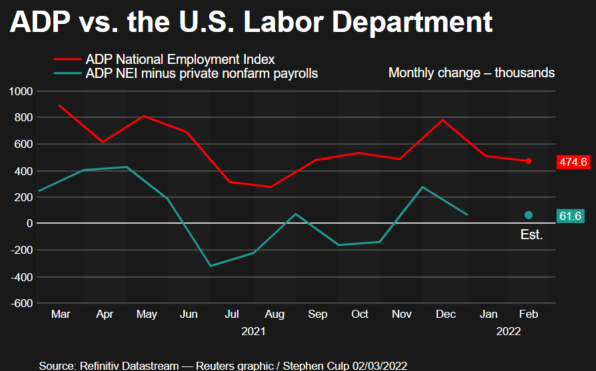A restaurant advertising jobs looks to attract workers in Oceanside, California, U.S., May 10, 2021. REUTERS/Mike Blake
Register now for FREE unlimited access to Reuters.com
WASHINGTON, March 2 (Reuters) – U.S. private employers hired more workers than expected in February and data for the prior month was revised sharply higher to show strong job gains instead of losses, aligning with other reports that have painted an upbeat picture of the labor market.
The ADP National Employment Report on Wednesday suggested the economy was on solid footing as the winter wave of COVID-19 infections driven by the Omicron variant was subsiding. But some economists raised concerns about the report’s credibility because of the sharp upward revision to January’s data.
Private payrolls increased by 475,000 jobs last month. Employers added 509,000 jobs in January rather than laying off 301,000 workers as was initially reported. Economists polled by Reuters had forecast private payrolls rising by 388,000 jobs.
Register now for FREE unlimited access to Reuters.com
“Huge revisions undermine ADP’s credibility,” said Michael Pearce, a senior economist at Capital Economics in New York. “Quite frankly, with January’s 301,000 reported drop revised into a 509,000 gain, the ADP figures are as much noise than signal.”
ADP Chief Economist Nela Richardson, however, said revisions were part of the process, drawing parallels with the Labor Department’s Bureau of Labor Statistics, which compiles the closely watched monthly employment report.
“If you look over the last three months, like the November, December (data), BLS also has substantially revised their numbers over the course of 2021,” said Richardson. “I think what’s important to remember is the overall trend. Both NER and the BLS are showing more than 6 million jobs created in 2021.”
The ADP report is jointly developed with Moody’s Analytics and was published ahead of the BLS’ more comprehensive and closely watched employment report for February on Friday. It has a poor record predicting the private payrolls count in the BLS employment report because of methodology differences.
While the initial ADP estimate showed private payrolls fell for the first time in a year in January, the BLS reported that the private sector hired 444,000 workers, with large upward revisions to employment gains in November and December.

UNRELIABLE PREDICTOR
“The ADP report is not always a reliable predictor of the BLS data, but it does suggest that our expectations for Friday are pretty reasonable,” said Daniel Silver, an economist at JPMorgan in New York.
According to the ADP report, large companies accounted for almost all of the job gains in February, with employment at small businesses declining by 96,000. Businesses continue to report difficulties finding workers. There were a near record 10.9 million job openings at the end of December.
Tightening labor market conditions are feeding into higher inflation pressures. Federal Reserve Chair Jerome Powell told lawmakers on Wednesday that the U.S. central bank would move forward with plans to raise interest rates this month, but Russia’s war against Ukraine had made the outlook “highly uncertain.” read more
Economists are expecting as many as seven rate hikes this year. Stocks on Wall Street were trading higher. The dollar rose against a basket of currencies. U.S. Treasury prices fell.
“We expect little fallout on the U.S. labor market, but there are major downside risks in the months ahead,” said Gus Faucher, chief economist at PNC Financial in Pittsburgh, Pennsylvania. “These include a recession in Europe, even higher inflation because of rising energy prices, and the increasing likelihood that the Fed could be forced to raise interest rates so aggressively to combat inflation that the recovery stalls.”
Indications are that companies maintained a strong pace of hiring in February. Data from Homebase, a payroll scheduling and tracking company, showed substantial increases in the number of employees on the job as well as hours worked in mid-February.
According to UKG’s workforce activity report, shift work in February recorded its largest monthly gain since the spring of 2020. The workforce management software company said the surge meant that the impact of the Omicron variant of COVID-19 on hourly shift work was over.
That aligns with expectations for another month of solid employment gains in February. Nonfarm payrolls likely increased by 400,000 jobs after rising 467,000 in January, according to a Reuters survey of economists. Private payrolls are forecast to have increased by 378,000 jobs in February.
Register now for FREE unlimited access to Reuters.com
Reporting By Lucia Mutikani;
Editing by Chizu Nomiyama and Andrea Ricci
Our Standards: The Thomson Reuters Trust Principles.
